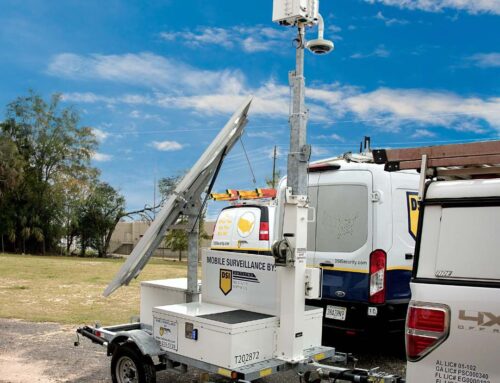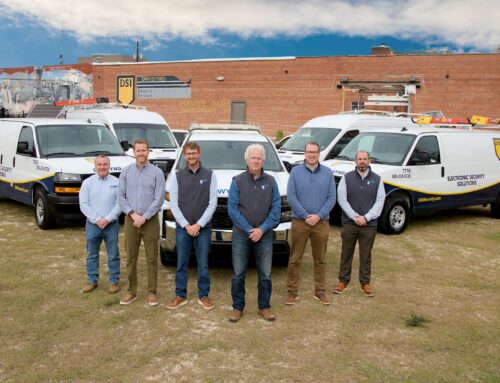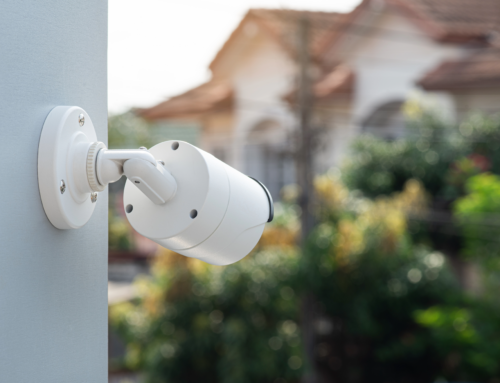By Jamie Ridenhour
Deter, Detect, Deny, Delay and Defend. Whether securing an individual room or a sprawling warehouse, these are the five D’s that a perimeter security plan should be built around. The object of the perimeter is to keep unauthorized people out of spaces that need to be protected, but allow authorized individuals to enter.
A wall or chain link fence around the outer boundary is often what the word perimeter brings to mind, but the concept is much more involved than that. A good perimeter involves numerous overlapping layers of physical, virtual and automated measures to ensure the protection of valuable assets. Outdoor perimeters in particular add distance, time and scale to a physical security plan, enabling security personnel to react before a threat reaches the building itself.
Deter
The outermost layer of the perimeter is meant to deter unwanted visitors from even trying to enter where they are not supposed to be. Typically, a mix of physical infrastructure, lighting, visible surveillance devices and signage are used to deter. While the barrier is physical, the battle is largely psychological. The goal is to make it look difficult enough that criminals won’t even try to breach it.
Detect
Detection is important both before and during an attempt to breach the perimeter. It is critical for security personnel to react to a breach, or even a suspected attempt, as quickly as possible. When a potential intrusion is detected early enough, a “talk down” may be enough. Officers, either remotely or in person, talk to the intruders and advise them to leave and of the consequences of not doing so. The reaction of the intruder plays an important part in determining the necessary response.
Security managers must stay aware of new technology, as it plays an increasingly large role in detection. Cameras and motion sensors are well established, while thermal imaging, artificial intelligence (AI), dynamic event detection and video management software (VMS) are relatively new. A good technology deployment allows all of these components to communicate with each other. An alert from a motion sensor can trigger a change in angle of a PTZ camera and notify staff.
AI and VMS can also be effective in stopping an intrusion before it even begins. Most people are aware of the use of AI in facial recognition, but even more powerful systems are now being put to use. Systems can now identify items or movements that are out of the ordinary, such as a backpack left for too long or someone running while everyone else is walking. Automated number plate recognition (ANPR) in conjunction with AI can provide alerts when vehicles have remained unattended for too long.
Most importantly, these systems facilitate automated 24 hour monitoring, in all weather conditions, of both the interior and exterior of the perimeter, alerting security personnel only when necessary. The use of AI is fast becoming a force multiplier for security teams, allowing fewer personnel to monitor a larger area more effectively. Security managers must be aware that a good system still requires well trained personnel to manage it, however.
Deny
The object of deny is to prevent an intruder from accessing sensitive areas. Access control technology or manned security checkpoints are the most common solutions for allowing authorized persons to enter a restricted area while denying access to those not authorized. Video surveillance is also part of the deny perimeter when coupled with biometric and card access systems. These tools are used not only to verify credentials, but also to immediately alert security personnel that unauthorized access is being attempted.
Access control is only as good as the authorization information it is based on. A good credential management system is critical. Ideally, access control systems should be in direct communication with HR and IT systems so that credentials are updated as soon as an employee is terminated or roles change. Regular audits are necessary to ensure that access is granted only to those that require it.
Delay
When a breach is attempted, the delay perimeter is meant to slow down an active intrusion.
Interior looking doors, double fences, bollards and other physical barriers create time for the security team to respond to an event and may even force the intruder to give up. Video surveillance is again a useful component, providing situational awareness for responding personnel. The security team may also be able to use video surveillance to pinpoint an intruder’s location and remotely lock the area down to create a trap.
Defend
Whether the intruder is confined or still on the loose, security personnel must be prepared to defend the perimeter. The goal of the first four perimeter items we’ve mentioned is to avoid a serious confrontation, but personnel must be ready for that possibility. Officers must be trained and prepared for prompt action and ready to quickly call in law enforcement if needed.
Assessing the Need for Perimeter Security
When assessing the need for perimeter security we should remember the threat is the potential intruder and the possible damages they can inflict. The vulnerability encompasses human, physical, information, or infrastructure assets that are open to exploitation or damage. Consequences include the monetary or life safety impacts of an occurrence.
Securing the perimeter is important. It is equally important that security managers understand that there is more to the perimeter than the fence around the campus. Incorporating deter, detect, deny, delay, and defend into the perimeter security plan is a significant step in furthering your sites overall security program.







